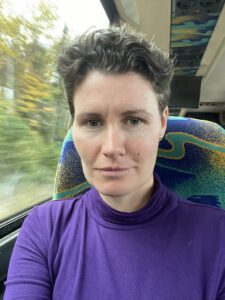How thrilling is it to be in a room full of people who share the same vision — the vision of Canadian communities with thriving mini forests. I had the pleasure to experience this at the Mini Forest Summit held in Ottawa on October 19.
I represented Green Communities Canada by serving on a panel discussion at the summit and joined a field trip to collect soil and water samples for lab analysis of soil carbon and environmental DNA.
As the Green Infrastructure Programs Lead at Green Communities Canada, it was a great opportunity for me to connect with our partners in the Network of Nature including Canadian Geographic, Dougan & Associates, the Delphi Group, and Wilder Community Solutions with whom we have been implementing the National Mini Forest Pilot program.
The Mini Forest Summit
The summit was held at the headquarters of the Royal Canadian Geographical Society: a beautiful venue that overlooks the Ottawa River where it converges with the Rideau and Gatineau rivers. The forest on the Gatineau side of the river was in full splendour — the leaves a mixture of yellows, oranges, and reds — setting the perfect backdrop.

Jenn on the way to Ottawa!
The event featured a series of panel discussions about the rationale behind mini forest plantings, opportunities for deployment across Canada, and limitations, including funding and supply chain constraints. Diana Beresford-Kroeger, an Irish-born botanist and medical biochemist, was invited to the event to receive an award from Canadian Geographic, and joined two of the panel discussions.
My panel, titled A Critical Role for Mini Forests, considered how the timing for mini forests is optimal right now. Mini forests can help address the dual crises of biodiversity loss and climate change, while empowering people to connect with their environment and communities by installing, maintaining, and enjoying mini forests.
Heather Schibli from Dougan and Associates spoke about her own experience installing a mini forest in her backyard, and its overwhelming successes in supporting biodiversity and creating new canopy cover. Charlene Williams of Vineland Research and Innovation shared their work analyzing soil carbon sequestration, and their current research studying this in new mini forests.
I outlined Green Communities Canada’s partnership with the Network of Nature for the National Mini Forest Pilot. Through the program, we have found that Canadians eagerly volunteer for these projects, demonstrating their desire to address climate change and biodiversity loss.
The other panels considered topics including assisted migration, and technology and citizen science. Maggie Ballantyne of the Greenbelt Foundation — who has graciously funded four mini forests in Ontario’s Greenbelt area this year — has written a blog about her panel discussion, outlining how mini forests align with the funding priorities of the Foundation.
The day’s events seemed to have filled the room with eagerness to move forward with new plantings.
Field trip
The second day of my Ottawa trip involved site visits to an old growth forest in Arnprior and a regrowth forest in Stittsville. The old growth forest called Gillies Grove is said to feature Ontario’s tallest tree, a towering white pine. The reforested site at Poole Creek Park, Stittsville, was along a creek with eastern white cedar as the dominant tree species.

Teams collecting soil samples for testing.
Two scientific research organizations took samples to study the soil carbon and biodiversity at both locations. Kat Bruce and Marta Felton from the leading environmental DNA analysis organization Nature Metrics collected soil sample at Gillies Grove and a water sample at Poole Creek while Charlene Williams from Vineland Research and Innovation Centre took soil samples from both sites.
The researchers also engaged with Grade eight students from Goulbourn Middle School at Poole Creek. The students had watched a video of Bruce presenting at COP15 prior to the field day and eagerly engaged with the scientists to learn more about this cutting-edge science.

Kids at the event collecting samples
Following the interaction with the students, the scientists also gathered samples from mini forests to compare soil carbon and biological diversity at the old growth site, the reforested site, and the mini forest sites. This important analysis will help us add more data to the limited research into mini forest outcomes in Canada.
All in all, it was an exciting opportunity for me to attend these activities and meet others so passionate about mini forests. I’m excited for the research results to be published soon and hope to share them with you in the next few months.

Recent Comments